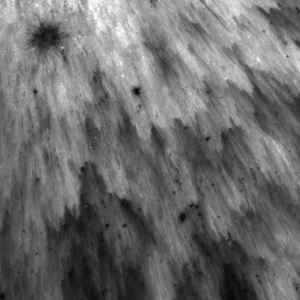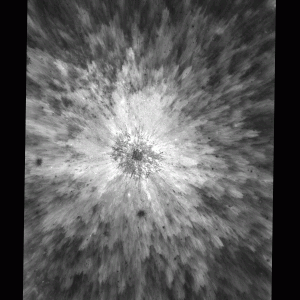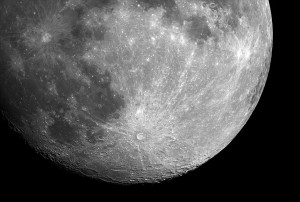Welcome back science fans!

Take a look at the amazing image above showing a close up view of crater rays, made when an asteroid slammed into the Moon’s surface, (image is 750 metres across). The extremely fine dusty material gets thrown upwards and outwards from the impact, to settle back down to the surface and create an almost action shot of the event. It’s like the site of an explosion, and the crater rays tell a story, and with some craters you can even tell from what direction, and at what angle the space object hit.
Visible ejecta like this can also be a sign of a crater’s age. When the fine, bright, dusty covering is not interupted with new impacts or other crater rays overlying it can be a sign of youth, also they degrade over time so a distinct and bright ray pattern can suggest a younger crater. You’ll notice there is a smaller, darker impact at the upper left that has crater rays all of its own. This smaller one looks to have happened since, as it shows no covering of the fine light material over it from the larger impact.
Get the bigger perspective below as the whole impact scene is revealed in this photo covering 2.2 kilometres. Darker spots are visible in the crater rays that seem to be boulders that have been thrown outwards from the blast site, sometimes these can make secondary craters surrounding the main one. These fantastic images were taken from the Nasa Lunar Reconnaissance Orbiter back in April 2011.

You can see crater rays for yourself, and the best time is full Moon. Check out the crater Tycho (Image below, bottom right) in the Moon’s southern highlands. Tycho at 85 kilometres across, is one of the Moon’s youngest craters at around 108 million years old, and a great place on the lunar surface for seeing crater rays. Tycho gets brightly lit by the Sun and is really easy to spot at full Moon, its fine powdery material has been blasted out from the impact site to up to 1,500 kilometres away creating long bright tendrils spreading out in all directions.
Also the crater Copernicus (image below, upper left) is another impact site that will show impressive rays in your binoculars or small telescope. Copernicus is slightly larger than Tycho, and is surrounded by darker material.

By John Brady of Astronomy Central